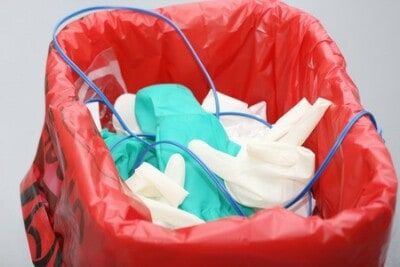Hygiene – The disposal of waste in hospitals
Hygiene is a top priority in hospitals. Infectious waste is produced daily, which in the case of poor hygiene represents a health risk for the employees who dispose of this waste.
The waste management officer therefore needs to have extensive knowledge of appropriate hygiene requirements and possible infection hazards.
The central task is defined by minimizing the risk of infection
Hygiene in hospitals has been hotly debated for many years. Not only because of nosocomial infections, i.e. the typical hospital infections. Thus a headline in the Wirtschaftswoche once read: „Dramatic hygiene deficiencies in hospitals“.
Sanitary disposal procedures are considered an essential component when it comes to avoiding infection risks for staff, patients and their visitors.
The various aspects of hygiene must be taken into account in the disposal of hospital waste in several areas:
- Work equipment (for example, the provision of suitable waste collectors in the hospital)
- Work techniques (the behaviors and work procedures to avoid the risk of infection)
- Spaces & Technical equipment (for example, pneumatic conveyors or disposal routes such as chutes for dirty laundry, which always represent a hygienic hazard and should therefore be viewed critically.)
- Personal hygiene requirements for employees involved in waste disposal tasks (for example, requirements that rooms with an increased risk of infection may only be entered after rings have been removed and hands disinfected).)
The ABC of disposal
A-Waste: This is commercial waste similar to household waste, which can be disposed of in normal household waste containers, as it does not pose any particular risk of infection.
Practical waste collectors are offered for this purpose, which are usually equipped with a foot-operated mechanism. These allow easy filling without the use of hands.
B-Waste: This includes waste containing blood, secretions and excretions. For this purpose, protective measures are taken within the hospital to ensure that the spread of the associated pathogens is prevented.
Once this special treatment is implemented, the waste can be added to Class A waste before it is picked up by the disposal contractor. The consolidation of both types of waste usually takes place in the central storage area.
C waste: These are infectious seizures, which can transmit diseases. To prevent the spread of these diseases, this garbage should not be poured over.
Otherwise, air vortices would be created during transfer, which would cause the formation of aerosols. This is how syringes and needles, for example, are disposed of. In order to ensure safe drainage, puncture-proof containers are used.
These consist of recyclable cardboard and are equipped with an additional plastic container on the inside. In this way, the risk of injury can be prevented.
It is important that the disposal of this type of waste takes place where the waste is generated. In addition, with regard to C-waste, care must be taken to ensure that the storage period is limited:
- Unrefrigerated for a maximum of four days,
- Refrigerated maximum 14 days.
The waste must then be incinerated as hazardous waste or can be disposed of with household waste after disinfection.
D-waste: Waste requiring monitoring, such as chemicals, falls into this class. Environmentally hazardous waste such as photographic or used chemicals must be disposed of as hazardous waste.
The storage of these chemicals may only take place in rooms that do not have access to a sewer system. Only specialized companies can be considered to handle this complex type of disposal.
E-waste: This refers to ethical waste such as tissue remnants or body parts. These materials must be handled with care and disposed of only in liquid-tight containers.
If only small quantities are involved, it is possible to treat them as C-waste. This waste, some of which is contaminated, is collected in special incinerators and sent for cremation.
Waste managers and employers are responsible for infectious waste
The employer is obliged to evaluate the health risks to which his employees are exposed by biological agents.
Within the framework of this assessment, which is obligatory according to the Biological Agents Ordinance, the disposal activities must also be involved.
Waste officers have the duty to monitor the disposal routes. Until it is disposed of or recycled. They are also required to inform employees of the risks involved.
Waste managers in medical facilities must clarify or ensure the following aspects:
As the person responsible for waste in medical and medical-related facilities, you should clarify the following aspects:
Is there a hygiene plan?
Healthcare facilities are required by the Infection Protection Act to have a hygiene plan in place. This hygiene plan also includes the safe disposal of contaminated waste.
The requirements for the hygiene plan can be found in the technical regulation TRBA 250.
Is there waste to be disinfected??
Whether this is the case and which wastes must be disinfected must be clarified with the physicians in charge of hygiene and other hygiene specialists.
If disinfection is necessary, thermal processes should be preferred, as chemical processes are less safe and pollute the environment.
